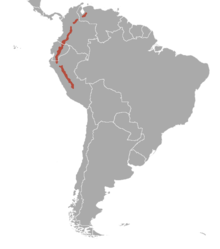| Pudu Temporal range: Pleistocene – recent
| |
|---|---|

| |
| Southern pudu (P. puda) | |
| Scientific classification | |
| Domain: | Eukaryota |
| Kingdom: | Animalia |
| Phylum: | Chordata |
| Class: | Mammalia |
| Order: | Artiodactyla |
| Family: | Cervidae |
| Subfamily: | Capreolinae |
| Tribe: | Odocoileini |
| Genus: | Pudu Gray, 1852 |
| Type species | |
| Capra puda Molina, 1782
| |
| Species | |
|
Pudu puda (Molina, 1782)[1][2] | |

| |
| Geographic range of Pudu puda | |

| |
| Geographic range of Pudu mephistophiles | |
| Synonyms | |
|
Pudua Garrod, 1877 | |
The pudus (Mapudungun püdü or püdu,[4] Spanish: pudú, Spanish pronunciation: [puˈðu]) are two species of South American deer from the genus Pudu, and are the world's smallest deer.[5] The chevrotains (mouse-deer; Tragulidae) are smaller, but they are not true deer. The name is a loanword from Mapudungun, the language of the indigenous Mapuche people of central Chile and south-western Argentina.[6] The two species of pudus are the northern pudu (Pudu mephistophiles) from Venezuela, Colombia, Ecuador, and Peru, and the southern pudu[7] (Pudu puda; sometimes incorrectly modified to Pudu pudu[8]) from southern Chile and south-western Argentina.[9] Pudus range in size from 32 to 44 centimeters (13 to 17 in) tall, and up to 85 centimeters (33 in) long.[10] The southern pudu is classified as near threatened,[11] while the northern pudu is classified as Data Deficient in the IUCN Red List.[12]
- ^ Molina, Giovanni Ignazio (1782). "Il Pudu, Capra Puda". Saggio sulla storia naturale del Chili. Bologna: S. Tommaso d'Aquino. pp. 308–309.
- ^ Molina, J. Ignatius (1809). The Geographical, Natural, and Civil History of Chili. Longman. p. 256.
- ^ de Winton, W. E. (1896). "On some Mammals from Ecuador". Proceedings of the Zoological Society of London. 64 (2): 508–512. doi:10.1111/j.1096-3642.1896.tb03055.x.
- ^ Muñoz Urrutia, Rafael, ed. (2006). Diccionario Mapuche: Mapudungun/Español, Español/Mapudungun (in Spanish) (2nd ed.). Santiago, Chile: Editorial Centro Gráfico Ltda. p. 184. ISBN 956-8287-99-X.
- ^ "Southern Pudu". Animal Planet. 2009. Retrieved 19 September 2009.
- ^ Cite error: The named reference
placentation.ucsd.eduwas invoked but never defined (see the help page). - ^ Huffman, Brent (2006). "Southern Pudu". Archived from the original on 2009-04-06. Retrieved 2009-09-17.
- ^ Hershkovitz, Philip (1982). Neotropical deer (Cervidae) : Part I. Pudus, genus Pudu Gray. Pp. 60-61. Fieldiana Zoology new series, no.11.
- ^ Grubb, P. (2005). Wilson, D. E.; Reeder, D. M. (eds.). Mammal Species of the World: A Taxonomic and Geographic Reference (3rd ed.). Baltimore, MD: Johns Hopkins University Press. ISBN 0-8018-8221-4. OCLC 62265494.
- ^ Schürer, Ulrich (1986). "Pudu pudu" (PDF). Convention on International Trade in Endangered Species of Wild Fauna and Flora. Retrieved 17 September 2009.[dead link]
- ^ Silva-Rodríguez, E.; Pastore, H.; Jiménez, J. (2016). "Pudu puda". IUCN Red List of Threatened Species. 2016: e.T18848A22164089. doi:10.2305/IUCN.UK.2016-1.RLTS.T18848A22164089.en. Retrieved 12 November 2021.
- ^ "Pudu mephistophiles". IUCN Red List of Threatened Species. 2016: e.T18848A22164089. 2021. doi:10.2305/IUCN.UK.2016-1.RLTS.T18848A22164089.en.